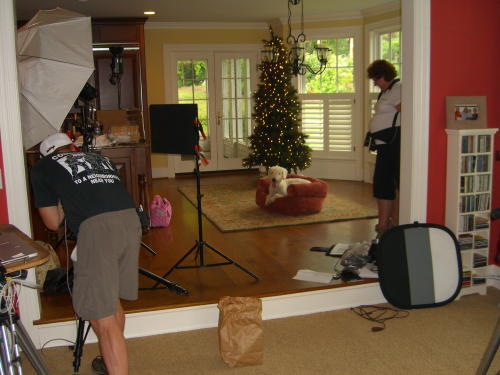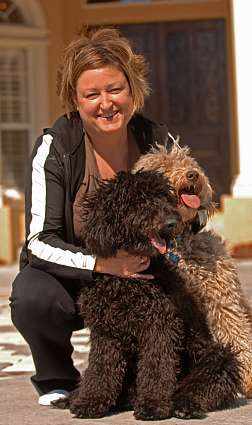Our Labradoodles in Print!

Click below to find more information on our Labradoodle puppies.
Labradoodle Details in the News
 Over the years we have been featured in various news articles and magazines. Some are featured below.
Over the years we have been featured in various news articles and magazines. Some are featured below.
Rainmaker Ranch North Casadilla's "Casey" Photo Shoot 2006
Casey at her July, 2006 photo shoot for Grandin Road/ Frontgate Catalog. We are very proud of Casey and of course Kathy, our Rainmaker Ranch North Breeder and Casey's in home trainer, in their training and work for the event.
Shaggy dog story: Orlando Sentinel February 19, 2006
Krista Waitz's Lab-poodle hybrids are one in a spate of 'designer' breeds sweeping the canine kingdom. But can these tousled cuties ever win the respect of the Westminster set?
Kate Santich
Sentinel Staff Writer
February 19, 2006
First, there's the funny name. Labradoodle. It sounds like something invented for a children's cartoon.
Then there's the look -- shaggy, curly, with a teddy-bear face and sort of loopy demeanor, like it doesn't take life all that seriously.
If it were human, it would wear Hawaiian shirts and flip-flops. 
Can't you just picture this creature at the snooty Westminster Kennel Club's very, very prestigious, very discriminating, 130-year-old dog show in Madison Square Garden? Can't you see the judge bending down to inspect its teeth only to get a big, slobbery kiss? Can't you imagine it wandering off backstage to sniff some blow-dried, long-coated Chihuahua?
Yes, it might be hard for some to envision a Labradoodle in the same league as, say, the chi-chi Cavalier King Charles spaniel or the fine-featured smooth-haired Ibizan hound.
But Krista Waitz -- Windermere dog breeder, activist, architect, wife and mother -- has a dream.
One day, hopefully in the not-too-distant future, one of her beloved Labradoodles will stand in the ring at Madison Square Garden, alongside the shepherds and the hounds and the terriers. And it will make her proud.
It will make her mission complete.
"Callie! Off the coffee table!" she says, interrupting the mood to correct her exuberant fifth-generation doodle, a $2,500 latte-colored cutie who bounds off the furniture with what looks for all the world like a mischievous grin.
"They're really very laid back," Waitz offers. "But when there is company, they need a couple of minutes to settle down."
The Labradoodle, as you might expect, is a mix of the muscular Labrador retriever and the fine-featured poodle. It's typically good with kids, easy to train, extremely clever, good-natured -- and, well, a little comical at times.
It's also one of the more advanced "designer dogs" that have become the latest trend in the canine kingdom. Breeders are mixing a growing list of purebreds hoping to come up with a hybrid that's cute, smart, obedient, hypoallergenic -- and highly marketable.
Thus we have the puggle (pug and beagle), the Chi-chon (bichon frise and Chihuahua), the Labradinger (English springer spaniel and Labrador) and the snorkie (miniature schnauzer and Yorkshire terrier), to name but a few of the 200-plus creations.
But Waitz did not fall in love with the Silky Tzu or the peke-a-pap or the schipper-poo. A former poodle breeder, she fell in love instead with the Labradoodle.
"They're poodles in casual clothes," she says affectionately. She has three of them -- Roxie, the grandmother; Callie, the mom; and Bella, the 6-month-old baby, a dark bundle of energy.
Two years ago, Waitz, on the board of directors of the International Labradoodle Association, began writing to the venerable American Kennel Club for breed recognition. Such acceptance would give owners a way to track the dog's ancestry, ensuring clean bloodlines, and give the Labradoodles a chance to compete in the majors.
Waitz hoped for a blessing.
What she has gotten instead is a spot in the middle of a rather nasty catfight.
Canine crosscurrents
As Westminster crowned its champion last week, dog and owner poised proudly in the spotlight. And why not? It had taken generations of breeding, years of pampering, months of training and travel, and a small fortune in expenses to reach the pinnacle of show-dog-dom.
And these days, no one gets to Westminster without first getting into the American Kennel Club, which has recognized a slowly expanding list of purebreds over its long history. In 2004, for instance, it added the Neapolitan mastiff, a massive, lumbering beast with deep, abundant wrinkles and loose skin over its entire body.
"The breed is well over 500 years old," Daisy Okas, spokeswoman for the American Kennel Club, says of the mastiff. "It wasn't like they just invented it and said, OK, here you go. So just because people are capitalizing on putting two breeds together and creating a funny name doesn't justify making it a purebred."
Okas is actually more diplomatic than most objectors, who say things such as "those doodle dogs. . . "
Consider the outrage of the Poodle Club of America, which has not been fond of any dilution to its gene pool. The Labradoodle, which, unlike many designer-dog attempts, has mushroomed in popularity, is particularly irksome.
"We must, in order to protect our breed from further exploitation, sell pet [poodle] puppies on a spay-neuter contract to stop them falling into the wrong hands," writes publicity chairman Anne Rogers Clark on the Poodle Club's Web site. "Do not ever allow your stud dog to be bred to a bitch of another breed. If you are a member of a breed club, this could put you in line for charges being brought against you. Why? This is not responsible behavior . . . Beware."
Likewise, the Labrador Retriever Club has taken a stance against the hybrid, calling the Labradoodle "nothing more than an expensive mongrel."
Ouch.
Purebred owners who lend their dogs to such pairings have been blacklisted from both breed clubs and shows. They are snubbed and derided by fellow breeders.
"I don't even go to the online discussion forums anymore," says Garry Garner, executive director of the American Canine Hybrid Club. "There is so much hate on there. The die-hard breeders don't think that anybody else has a right to exist."
In truth, though, virtually all purebreds were hybrids once upon a time. Although a handful can trace their lineage to ancient times -- depictions of pharaoh hounds were found in Egyptian tombs from 4,400 B.C. -- many were bred to fulfill a specific purpose.
Rat terriers chased vermin. Boxers pulled carts and served as cattle dogs. The sometimes-hairless Chinese crested helped to keep the Aztecs' beds warm -- when they weren't being served for dinner.
Paired with purpose
The Labradoodle, despite rumors it was the product of an over-the-fence escapade, was actually also designed with a purpose. In the 1980s, an Australian breeder named Wally Conron sought to produce a guide dog suitable for families with allergies. The Lab was known to be loyal and friendly -- and to shed fiercely. The poodle, on the other hand, shed very little, but its diva image didn't go over well with men.
The Labradoodle began as a simple cross between the two, but the result turned out to be sometimes hypoallergenic, sometimes not. It was only when Conron and others bred Labradoodles to poodles and a handful of other dogs that they got what they wanted with some consistency.
With careful selection and expensive medical screening, breeders such as Waitz are able to produce dogs that both shed very little and escape the typical health problems of both parent breeds, such as hip dysplasia, elbow and knee problems, cataracts and skin allergies.
But therein lies much of the controversy. Not every breeder is careful or wants the healthiest puppies or the best bloodlines. Some will breed any dog, no matter what sort of inheritable health woes it has, just to make a quick buck.
"I think there are some legitimate concerns," Garner says. "If breeders are just jumping on it because it's popular -- that's a problem. And that's true for both purebred and hybrid breeds. When a dog becomes popular, it almost ruins the breed."
Too many dogs are bred too fast and sold to people who wind up paying big vet bills or finding out that the dog doesn't mix well with their cat or child or busy lifestyle or, pathetically, even their sofa.
"We have so many mixed breeds in our shelters, why would you want to create more?" says Mary Beth Lake, animal care supervisor for Seminole County Animal Services. "We've got plenty of designer dogs right here, so come down and get one -- for $65."
Hoping for recognition
"Bella! No kisses!" Waitz chastises her youngest as the dog licks the ear of a visitor.
At age 41, with three dogs, a 12-year-old daughter and 18-month-old son, Waitz has her hands full. She doesn't have endless time to lobby for Labradoodle respect.
In her two-year-long exchange of correspondence with the AKC, she has been getting pretty much the same generic reply, listing the organization's rules on purebreds.
It would seem that her plea has merit. After all, she and other breeders have produced eight generations* of consistent Labradoodle offspring, and they've set up a club with breed standards and strict health requirements and a registry of 2,000 dogs. Further, there are perhaps as many as 200 Labradoodles working as service dogs in North America.
"We think we've fulfilled all of the AKC's requirements," she says.
Then she shrugs.
It is not easy seeing someone you love be rejected.
"We realize it might take 10, 20 years," she says, still sounding hopeful.
Meanwhile, she knows that when she's out and about with one of her four-footed companions to expect the sideways looks and snide remarks. They're part of the package.
"Oh," a purebred breeder will say, glancing at Waitz's pooch and lifting her eyebrows. "A mistake."
And Waitz will smile.
"Actually," she'll reply, "it was very much on purpose."
Kate Santich can be reached at 407-420-5503 or ksantich@orlandosentinel.com.
*Please note there was a misrepresentation in the interview. Rainmaker Ranch Labradoodles breeds 3rd to 5th generation Australian Labradoodles and 2nd generation Labradoodle to 5th generation Australian Labradoodle together and in no way wishes to represent that we have ever bred further down the generation pedigree. Please note, each time you breed an Australian Labradoodle 5th generation to a 3rd generation it technically is called a 4th generation, one higher than the lowest generation therefore we may never reach 8 generations on the grading scheme for years and even with the grading scheme taken out of the equation we have been breeding Australian Labradoodles for only a few generations over 5 years. We are a small breeder and focus more on quality consistent results. This stated, we do not believe you as a consumer should even consider generation beyond 3rd a priority. Instead health, temperament, conformation, and coat should be your criteria. Please look at a breeders breeding dogs including ours, the offspring will be a result of these parents and reflect the health, temperament and conformation of these parents and even grandparents. If you do not see what you would like in a puppy in the breeding dogs look elsewhere regardless of the generation. RRL
Wall Street Journal Article: December, 2005